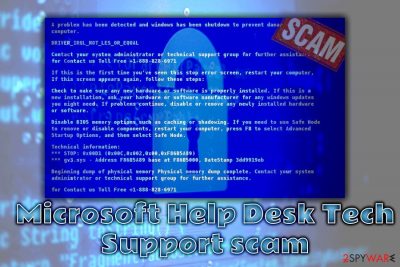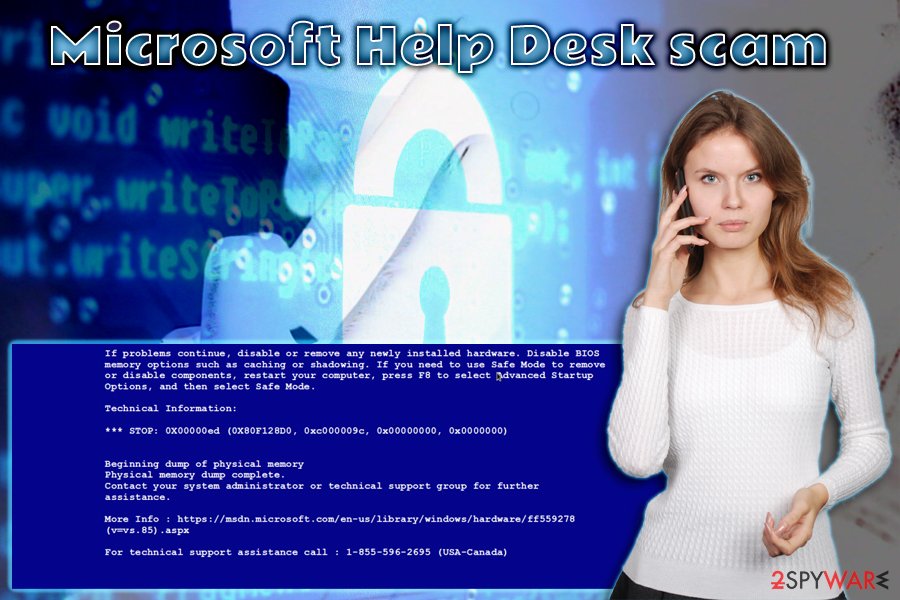Microsoft Help Desk Tech support scam (Simple Removal Guide) - updated Sep 2018
Microsoft Help Desk Tech support scam Removal Guide
What is Microsoft Help Desk Tech support scam?
Microsoft Help Desk Tech Support scam is a screen-locker that urges victims calling fake Windows specialists

Microsoft Help Desk Tech Support is a fake message that is shown of Windows desktop users after they get infected with a trojan. The bogus error message is displayed as a Blue Screen of Death (BSoD) and does not allow victims to access their desktop or use applications installed. Unfortunately, a PC restart does not prove to be useful either, and users are shown the same locked screen again. As typical for tech support scams, the fake error states about some troubles (in this case, bad actors claim that there is a problem with gv3.sys files), prompting users to call a toll-free number presented in order to fix their machines. However, Microsoft Help Desk Tech Support authors should not be trusted, as this merely a scam.[1]
| SUMMARY | |
| Name | Microsoft Help Desk Tech Support |
| Type | Trojan |
| Sub-type | Tech support scam |
| Propagation | Spam emails, malicious sites, file-sharing domains, fake updates, etc. |
| Symptoms | A locked screen displaying a fake BSoD; Inability to access desktop |
| Detection and elimination | Use anti-spyware program to remove malware, then use FortectIntego to make sure Windows is repaired |
Though this time the crooks did their best by devising an elaborate scam, some features reveal the true nature of such malware. Therefore, we urge you to remove Microsoft Help Desk right away before it fully entangles your operating system.
You can use reputable anti-malware software that would detect and remove Microsoft Help Desk virus from your computer promptly. However, since the access to the PC is denied, you will have to access Safe Mode with Networking in order to be able to enable security software.
Fake Microsoft Security Essentials window informs that the application has detected malicious files on the system. It also includes the number of a supposed technician number. However, if you do not have this application installed on your device, such alerts look more than fishy. Furthermore, genuine notifications of a reputable anti-virus program never suggest you call any number.
Despite increasing public awareness, tech support scams are on the rise [2]. Recently, the emerging versions of support scams have been improved up to the point that they contain elements of ransomware as well. In relation to this, Microsoft Help Desk Tech also asks you to restart the computer to prevent further damage. Do not comply with hackers suggestions. Rebooting the device might accelerate a process of infection with Microsoft Help Desk Tech hijack. Interestingly, that there has been a rise of file-encrypting malware which impersonates tech support scams [3].
Microsoft Security Essentials detected 5 potential threats that might compromise your privacy or damage your computer. Microsoft Security Essentials wasn't able to block the virus. Helpline: +1-888-828-6971
Microsoft Help Desk Tech Support notification also provides technical information to convince of the legitimacy of such claims. It states that some errors occurred related to gv3.sys file. Initially, the original file is a legitimate component of Windows OS files. Such a maneuver tries to cover tracks of the malware.

What happens if you call the given number in an attempt to contact Microsoft Help Desk Tech Support fake technicians? There are several outcomes.
In the first case, a felon might lead you through a series of steps which, later on, grant the crooks remote access to your computer. Secondly, due to the “Microsoft Help Desk Tech” redirect, you might be misguided to a domain which contains a bunch of severe cyber infection. As a matter of fact, the very malware is regarded to be a trojan [4].
In any case, we encourage you to start “Microsoft Help Desk” removal. As soon as the elimination is completed and the normal operation of the operating system is regained, you should make use of FortectIntego software as it can fix all the damage done by the Microsoft Help Desk Tech Support malware.
Malware transmission methods
If you tend to visit questionable and file-sharing domains, the risk to encounter a virus boosts up. By clicking the corrupted link or the ad, you might end up on a malware-ridden website and install a trojan without even realizing it.
Such infections might also fish for new users via exploit kits when users visit hacked or malicious site, where JavaScript scans the machine for certain vulnerabilities that could be exploited. Evading them without a proper security shield is quite complicated [5]. Therefore, we recommend using a powerful anti-malware tool with the real-time protection feature.
Additionally, beware of phishing and scam emails. They impersonate official institutions to convince users into opening the infected attachments. You never know what kind of malware might hide there.
Ways to remove Microsoft Help Desk Tech Support scam
While most scams show up on browsers like Google Chrome, Internet Explorer, Mozilla Firefox, Sari, or others, Microsoft Help Desk Tech Support virus appears as a screen-locker, which prevents users from accessing the machine. Essentially, the scam is a trojan that tries to convince users about the seriousness of the situation.
To remove Microsoft Help Desk Tech Support scam, you should employ reputable security software that is capable of detecting and getting rid of it. But before that, you need to access Safe Mode with Networking, as accessing the desktop is impossible in the normal mode.
As soon as Microsoft Help Desk Tech Support removal is complete, you should run a complementary software like FortectIntego. It will fully fix the damage done by malware and recover broken Windows files.
Getting rid of Microsoft Help Desk Tech support scam. Follow these steps
Manual removal using Safe Mode
To be able to remove Microsoft Help Desk scam, enter Safe Mode with Networking the following way:
Important! →
Manual removal guide might be too complicated for regular computer users. It requires advanced IT knowledge to be performed correctly (if vital system files are removed or damaged, it might result in full Windows compromise), and it also might take hours to complete. Therefore, we highly advise using the automatic method provided above instead.
Step 1. Access Safe Mode with Networking
Manual malware removal should be best performed in the Safe Mode environment.
Windows 7 / Vista / XP
- Click Start > Shutdown > Restart > OK.
- When your computer becomes active, start pressing F8 button (if that does not work, try F2, F12, Del, etc. – it all depends on your motherboard model) multiple times until you see the Advanced Boot Options window.
- Select Safe Mode with Networking from the list.

Windows 10 / Windows 8
- Right-click on Start button and select Settings.

- Scroll down to pick Update & Security.

- On the left side of the window, pick Recovery.
- Now scroll down to find Advanced Startup section.
- Click Restart now.

- Select Troubleshoot.

- Go to Advanced options.

- Select Startup Settings.

- Press Restart.
- Now press 5 or click 5) Enable Safe Mode with Networking.

Step 2. Shut down suspicious processes
Windows Task Manager is a useful tool that shows all the processes running in the background. If malware is running a process, you need to shut it down:
- Press Ctrl + Shift + Esc on your keyboard to open Windows Task Manager.
- Click on More details.

- Scroll down to Background processes section, and look for anything suspicious.
- Right-click and select Open file location.

- Go back to the process, right-click and pick End Task.

- Delete the contents of the malicious folder.
Step 3. Check program Startup
- Press Ctrl + Shift + Esc on your keyboard to open Windows Task Manager.
- Go to Startup tab.
- Right-click on the suspicious program and pick Disable.

Step 4. Delete virus files
Malware-related files can be found in various places within your computer. Here are instructions that could help you find them:
- Type in Disk Cleanup in Windows search and press Enter.

- Select the drive you want to clean (C: is your main drive by default and is likely to be the one that has malicious files in).
- Scroll through the Files to delete list and select the following:
Temporary Internet Files
Downloads
Recycle Bin
Temporary files - Pick Clean up system files.

- You can also look for other malicious files hidden in the following folders (type these entries in Windows Search and press Enter):
%AppData%
%LocalAppData%
%ProgramData%
%WinDir%
After you are finished, reboot the PC in normal mode.
Remove Microsoft Help Desk Tech support scam using System Restore
You can also try to eliminate the trojan by using System Restore:
-
Step 1: Reboot your computer to Safe Mode with Command Prompt
Windows 7 / Vista / XP- Click Start → Shutdown → Restart → OK.
- When your computer becomes active, start pressing F8 multiple times until you see the Advanced Boot Options window.
-
Select Command Prompt from the list

Windows 10 / Windows 8- Press the Power button at the Windows login screen. Now press and hold Shift, which is on your keyboard, and click Restart..
- Now select Troubleshoot → Advanced options → Startup Settings and finally press Restart.
-
Once your computer becomes active, select Enable Safe Mode with Command Prompt in Startup Settings window.

-
Step 2: Restore your system files and settings
-
Once the Command Prompt window shows up, enter cd restore and click Enter.

-
Now type rstrui.exe and press Enter again..

-
When a new window shows up, click Next and select your restore point that is prior the infiltration of Microsoft Help Desk Tech support scam. After doing that, click Next.


-
Now click Yes to start system restore.

-
Once the Command Prompt window shows up, enter cd restore and click Enter.
Finally, you should always think about the protection of crypto-ransomwares. In order to protect your computer from Microsoft Help Desk Tech support scam and other ransomwares, use a reputable anti-spyware, such as FortectIntego, SpyHunter 5Combo Cleaner or Malwarebytes
How to prevent from getting malware
Protect your privacy – employ a VPN
There are several ways how to make your online time more private – you can access an incognito tab. However, there is no secret that even in this mode, you are tracked for advertising purposes. There is a way to add an extra layer of protection and create a completely anonymous web browsing practice with the help of Private Internet Access VPN. This software reroutes traffic through different servers, thus leaving your IP address and geolocation in disguise. Besides, it is based on a strict no-log policy, meaning that no data will be recorded, leaked, and available for both first and third parties. The combination of a secure web browser and Private Internet Access VPN will let you browse the Internet without a feeling of being spied or targeted by criminals.
No backups? No problem. Use a data recovery tool
If you wonder how data loss can occur, you should not look any further for answers – human errors, malware attacks, hardware failures, power cuts, natural disasters, or even simple negligence. In some cases, lost files are extremely important, and many straight out panic when such an unfortunate course of events happen. Due to this, you should always ensure that you prepare proper data backups on a regular basis.
If you were caught by surprise and did not have any backups to restore your files from, not everything is lost. Data Recovery Pro is one of the leading file recovery solutions you can find on the market – it is likely to restore even lost emails or data located on an external device.
- ^ Christian Cawley. What Should You Do About the Windows Tech Support Scam?. MakeUseOf. We teach technology.
- ^ Jerome R. Stockfisc. Tech support, ransom computer scams are making the rounds again. The Ledger. News site..
- ^ Malwarebytes rolls out free decryption tool for VindowsLocker ransomware victims. Windowsreport. Windows 10 and Microsoft News, How-to-Tips.
- ^ John Fuller . How Trojan Horses Work. HowStuffWorksTech. Award-winning source of unbiased IT explanations.
- ^ Surging Tech Support Scams and How to Avoid Them. TrenMicro. Securing your Journey to the Cloud..





















